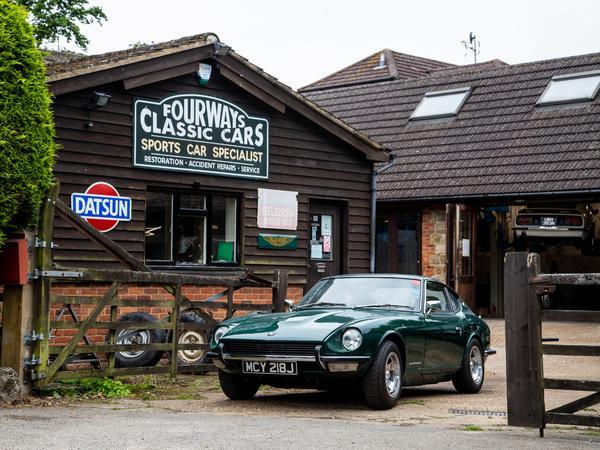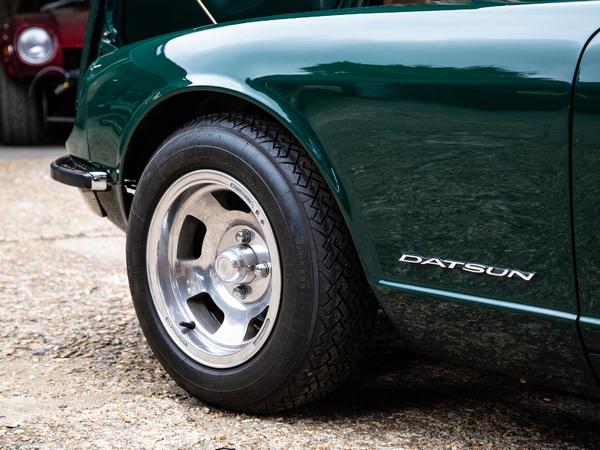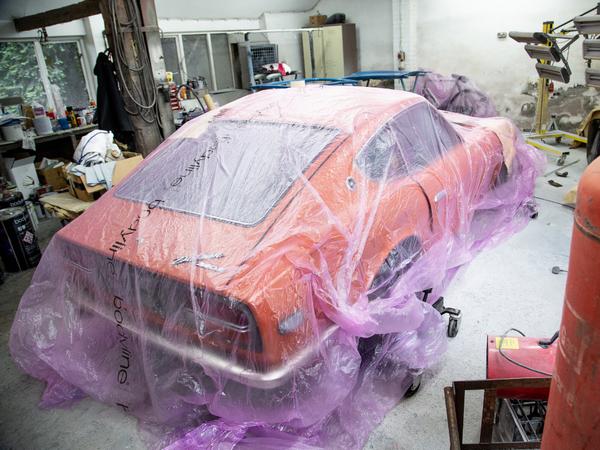Fourways Engineering | PH Meets
With the 240Z 50th this year and business booming, we visit one of Britain's leading Datsun Z specialists

It's the smell that gets you first. Not the eggy 21st century whiff of catalysed exhaust fumes, but the potent 20th century pong of unburnt hydrocarbons billowing out of the tailpipes of the cold-started car that's now reversing out of this brick and timber garage.
Then the car's back end angles into view. If you didn't know you were at the Borough Green, Kent home of Fourways Engineering, one of the UK's leading Datsun 240Z specialists, you'd swear that those exquisite curves belonged to some obscure example of 1960s Italian exotica, the sort of thing PH forumers would happily spend years trying to identify.
But this is Fourways, and the car that is enjoyably poisoning your coughing PH representatives is a totally original and very early J-reg 240Z in dark green. Coincidentally, that's the same colour as the 240Z that did the first UK road test rounds back in spring 1972, a few months after the car's British debut at the October 1971 Motor Show. The 240Z had been on sale in Japan for a full two years before that, illustrating the leisurely timescale of car launches back then and also allowing mathematicians to proudly shout that 2019 must therefore be the 50th anniversary of the 240Z.

You'd be forgiven for not noticing that. Although the brand has recently been resuscitated in Japan for city squirters, there hasn't been a Datsun presence in the UK since the mid-1980s. Even when Datsun was going strong in the UK in the 1970s and 1980s, the 240Z was a bit of an oddball choice.
Almost all of Datsun UK's sales back then were of cheap runarounds like the Cherry and Sunny, grudgingly purchased by a suspicious British public that still thought a Japanese car was about as durable as a cake left out in the rain. A performance coupe marooned in a range of character-free tin boxes was a jump too far for many potential buyers. Why would you get a tinny 240Z when you could buy a proper British sporting vehicle like the highly reliable Lotus Elan 4+2S, the delicate, will o' the wisp MGC GT with its pig-iron 2.9 litre six from the 1961 Austin Westminster saloon, or the not at all incendiary fibreglass Reliant Scimitar GTE?
Skeptics fearing a new Japanese invasion had their opinions conveniently reinforced by the opinions of British road testers, some of whom told them that certain aspects of the 240Z weren't so great. This was surprising, because the Datsun had won the previous year's murderously difficult East African Safari Rally and would go on to win it again in 1973. Hardly the hallmark of a poor car, even one that had been rally-prepped.

It turned out however that most of the 240Z's perceived shortcomings were down to a combination of misguided press expectations, crappy ancillaries that weren't really Datsun's fault, and the shocking state of the solitary (and heavily-abused) UK press vehicle. The unwillingness of Datsun UK's PR department to fix the test car's serious transmission faults (reported to them by more than one magazine) was quite likely a result of the, shall we say, unusual management style of Datsun UK founder and fortune-builder Octav Botnar.
The road noise noticed by even the most Mutt and Jeff of muttering rotters could well have been down to the famously liquorice-like Japanese Dunlop tyres of the era. As for expectations, those 1970s journalists thought they would be getting a grunty, low-revving six in the style of an Austin-Healey 3000, whereas in fact the Datsun's single overhead cam twin SU-carbed motor was a high revver that needed to be stirred beyond a then-outlandish (for a six) 4000rpm to get the best test figures.
If you were prepared to do that, the Z would hit 60mph at the top of second gear in 8.5sec and go on to 125mph in fifth. Maximum power was 151bhp at 5600rpm, not much less than Triumph's state of the art injected 2.5 PI inline six was producing at the time. 6000rpm was the Datsun's realistic limit, with a cutout at 6500. In everyday use, however, the 146lb ft maximum torque at 4400rpm meant you could row the Datsun along quite nicely without crossing the 4000rpm mark. In hardish use you could expect mpg figures in the low-20s, which as Calvin Harris nearly said was Acceptable In The Seventies.

But forget all that numbery stuff. Just look at it now. Wow. How well has that bodyshape matured? While everything else has become so big and bloated, the 240Z has become gorgeous simply by staying the same as it was in 1969. If, in some weird fantasy world, you opened a pop-up Datsun dealership tomorrow and the 240Z was your only offering, surely folk would be queuing round the block? Given the choice between a 2.4 carburetted six-banger weighing in at not much over a tonne and a new 1520kg Supra, which one would you pick?
Sitting in that showroom-spec green car, twirling the impossibly slender steering wheel, firmly coaxing the baulky gearstick around the gate and drinking in that uniquely matured aroma of petrol and plastic, the rock-solid investability of the Datsun makes this seem like a no-brainer choice. The thing is, it's a choice that you can actually make now, because thanks to the likes of Fourways Engineering you can get a beautifully restored/original 240Z for pretty much the same money as a new Supra, and a very acceptable one for not much more than half that. As long as Fourways are around - and that looks like being for a long time yet - you've got access to one of the deepest pools of 240Z knowledge and experience anywhere.
Fourways have been working on Zeds for almost as long as the car has been around. Founder Geoff Jackson was so taken by the 240Z on its launch that he flogged his E-type to get one. He loved the looks, layout and evident tunability of the Datsun, but there were no tuning parts for it, so Jackson spent the next forty-odd years developing his own cam, head, exhaust and chassis mods with a view to unlocking the car's motorsport potential. He passed away fairly recently but his good work is now being continued by James Carter, who spent four and a half years at Jackson's side, learning the ways of the master.

You don't have to do a lot to a 240Z to make it look, sound or go a whole lot better than Botnar and his whimpering acolytes ever imagined possible. Just take a little of the narrow-tyred, high-riding 1970s stance out of it, then play around with the mechanicals if you want. Or just leave it like it is. Either way you will be pleasantly surprised by the way it rolls.
'The weight distribution is great,' says James. 'You've got five of the six cylinders behind the front axle. They rust for fun though, which is why there aren't many UK cars left. They rust everywhere.
'In the 1990s these cars were worthless, so repairs were mainly on the "patch it up for the MOT" basis, but then they started to get a bit more popular so Geoff would import one from America and use a right-hand drive car as a donor. That way you'd get the ideal combination of a rust-free Californian shell and right-hand drive.'

James reckons that the perfect market for restored 240Zs is Australia, where they're snapped up for twice the price of US examples. Customer Paul's green car that was choking us earlier was originally brought over from Australia, where it cost the equivalent of just over £16,000 plus the 5% tax on historic vehicle imports. It was then subjected to a bare-shell, soda-blast restoration with all the original parts refurbished. And they mean all.
'I've always loved cars,' says happy owner Paul. 'I'd never really looked at a 240Z, but then I saw the ones here. I've had expensive cars but the massive premium you pay for them almost discourages you from using them. I had a Porsche 918 Spyder but it was just sitting in the garage.
'I started to look at other cars and I can honestly say that I've fallen in love with the 240Z. I bought mine to use. I have as much satisfaction driving this as I did the 918.'

The engines can be stroked to 3.2 litres using a 280Z block. 'They're generally really nice to work on,' says James. 'Fitting window regulators is the worst job ever, but getting engines and gearboxes in is easy and the rear suspension is so simple. The rear wishbones look different, but they're actually the same, it's just that one is upside down. That's how they did it. The number of people who ring us up saying they're looking at a car to buy but that one of the rear wishbones is wrong. It isn't. That's how they were. All four flexible brake pipes are the same too. That sort of thing is nice.'
The 240Z has other examples of Japanese ingenuity that you only notice when you look closely at the car, like the two inspection panels cut into the wing tops to allow access to the battery and screenwash bottle, and the nifty underbonnet light on a lead. Imagine a modern manufacturer fitting such a thing. No, neither can we. It would be a tacit admission of impending mechanical failure. Another pleasing design quirk appears in the 240Z cabin, where the crazily-low placement of the door releases almost makes you think you're in a gullwinged car.
So, you're looking to get into an early Z. Which one should you go for? The 260Z followup of 1974 was much the same car as the 240, its minimal power credits largely swallowed up by its emission debits. You could get a 2+2 version of the 260, adding some useful practicality without ruining the shape too much, but by the time of the 1978 280Z (which we didn't get in the UK) and the 1979 280ZX (which sadly we did), most of the Z's clean-cut appeal had been extinguished.

'A lot of people think the 260 is a slightly better driving car, with the extra four years of refining it had,' says James. 'But I'd always go for a 240. It's the icon. Always buy on the condition of the shell.' Such is the value of a good 240 now, however, even grotty ones are worth rescuing. 'We've done a UK car recently that needed £20,000 of bodywork. It looks stunning now.
'It's getting hard to find parts for the original gearboxes, so we do a nice 200SX gearbox conversion. It just takes a bit of machining.'
So, how much is 240Z ownership going to cost you then? A really good, ready to go restored car like Paul's green 54,000-miler would be in the region of £60k to buy. How about at the other end of the scale? 'A cheap, usable American LHD car with bad paint, interior and wheels is going to be around £15k. To get it restored properly, as opposed to just repainting it, you can add forty grand to that.'
Fourways don't just do 240Zs. They've earned their restoration spurs over the years on a raft of projects, including converting Aston DB4s to Zagato spec. While we were there, a rather spectacular '60s Mustang GT was being primped and honed for the owner who had just rolled up in his other car, an Aston DB11. Now he's thinking of getting Fourways' James to build him a nut and bolt bottom-up build of a 240Z. Eeeh, it's a tough life.
Thanks to all at Fourways for the hospitality and for persevering with the warm 'family business' approach to motor fettling. That means Nathalie Aldridge, James Carter, the Baker Brothers Jeff and Brian, apprentice James White, Mini-owning work experience lad Remy, and Teddy, the rescue Cavapoochon doggie.














Loving the restoration and the enthusiasm of Four Ways. The MCM 240 Fairlady with an RB26 is an interesting car too, for anyone who likes a Restomod.
Gassing Station | General Gassing | Top of Page | What's New | My Stuff



